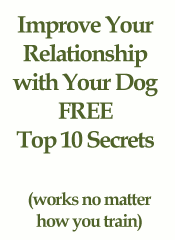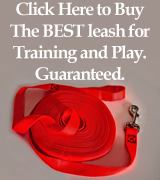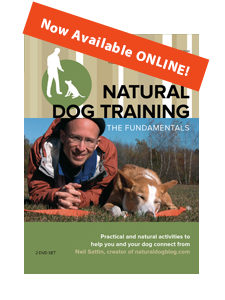You may recall that I am the proud person to a formerly aggressive dog, and that "curing" Nola's dog aggression was what led me to become a dog trainer in the first place. Since aggression is a fairly common issue with dogs, it has been widely discussed; however, much of the discussion revolves around HUMAN psychology - which really gets in the way of seeing dogs how they really are. In this article, I am going to give you a new way to look at what's happening with a dog that's aggressive, and talk about some basic ways to turn an aggressive dog into a peaceful pooch.
It might be helpful for you to revisit the article about how our dogs feel the world. Here's a quick summary:
- Our dogs are constantly feeling the world, receiving emotional energy from the world around them.
- If a dog is physically relaxed as the level of stimulation increases, they can handle lots of emotional energy, and they will "get in the flow". Getting in the flow often involves easy flips in polarity (i.e. between being prey and being predator) that allow them to either make contact - like with another dog, or make prey - like with a poor, unsuspecting squirrel.
- If a dog is NOT relaxed, then they can only experience so much energy before they experience an emotional overload. This overload can look like aggression, submission, anxiety, overfriendliness - basically any behavior that you might call "dysfunctional".
- Our goal as dog owners/trainers is to help our dogs be as relaxed as they can be, so that they can experience the energy of the world and stay happy in the midst of the mayhem.
The Natural Dog Training way of looking at our dogs is very simple. In any given situation we ask/answer the question "What is my dog doing with the energy that they're getting from the world?" We also use Natural Dog Training as a way of encouraging our dogs to give US their energy. In terms of aggression, this approach keeps the "why" very simple - we don't worry about whether it's "fear-based" or "territorial" - we just recognize that our dog was getting more energy than they could handle from the environment. A different dog might have rolled over and peed in the exact same situation, and if you were on the receiving end of the stream you might consider that to be an aggressive act!
For an "aggressive" dog, the world is simply spinning too quickly, and so they reach out to whatever the perceived cause of the spinning is to STOP the motion. Unfortunately our dogs use their jaws to grab a hold (due to a lack of opposable thumbs) - and if they're reaching out to grab another dog, that other dog will most often bite back.
So the important thing for you to do if you're dealing with an "aggressive" dog is to stop thinking about it as "aggression", and to start thinking about it as "inability to relax in moments of high stimulation". My reason behind this is two-fold. The first reason is because that IS, in fact, what you're dealing with. The second reason is that it will help you lose any sort of judgmental thoughts that you have about aggression - as those internal judgments often impair our ability to see what's going on and deal with the problem effectively. The more aware you are about what's really going on with your dog, the easier it will be to address the situation (or prevent it from happening entirely).
Let's say that you have a child who's very nervous around other children. Maybe your child is fine with one other child, but place that child in an overcrowded playroom and they're unable to function. You see all the telltale signs of nervousness in your child, but you decide to wait, hoping that they'll figure it out (and also not wanting to be the parent of "that child" - you know, the one who can't deal). Your child manages to find a little toy to play with, and all is well until...you guessed it, some other child comes over to play with the same toy. That other child is so eager that they just make a grab for the toy, and your child does what any nervous kid might do in that situation - clubs the other child over the head with the toy. Tears, mayhem - ah, the moment you had been dreading!
So what do you do?
Many parents in this situation would immediately scold their child for hitting the other child. The child has to know that what they did was wrong! There's also lots of pressure from other parents, who are now looking at you as if you're a bad parent, and looking at your child with disdain. So you have to perform for THEM as well. Maybe after the scolding the child gets to stay in the room - although they're more nervous than ever. As other children approach, you might say "now, don't hit that child!" - and the situation only escalates from there.
OK, step back for a moment. Who's really resposible for what just happened? The child? No way! Of course the answer is obvious...YOU ARE! There were clear signs of the child's nervousness, that the situation was too much for them to handle. And if you have a child who has trouble relaxing around other kids, do you think that the way to help them learn how to deal is to throw them into the middle of an overwhelming situation? And to scold them for acting the way that you could have predicted they'd act? Of course not.
The point of that isn't to lay blame at anyone's feet (and if you're feeling blamed, take a moment to just relax, breathe, and check in with your feelings). The point is simply to illustrate that our dogs often go through very similar circumstances, and that the correct response is to forget about the aggression and address what CAN be addressed - which are two things:
- The nervousness of the child (dog).
- Your ability to perceive what's happening (or about to happen) in a situation and respond pre-emptively (and much more effectively).
In the situation with the child, your #1 job would be to help that child get relaxed - and not to worry about reprimanding the child if you mistakenly let things get out of hand.
In stressful/stimulating situations with your dog, your #1 job is to help that dog get relaxed - and not to worry about reprimanding the dog if you mistakenly let things get out of hand.
So as you walk around in the world with a formerly-known-as-"aggressive" dog, think of yourself instead as the protector of this unable-to-relax being. Pay attention to what's happening with your dog as they experience the world, look for signs of physical (or emotional) tension, and address them immediately (here is an article on how to relax your dog). You can also practice "pushing" with your dog, which is the fundamental Natural Dog Training technique that helps you redirect and resolve all the energy that's stirred up inside of them. Use pushing at the first signs that your dog is energized, giving them an outlet before the energy seeks a less desirable path.
If an altercation happens, offer your apologies - but don't worry about scolding your dog. Instead, make a promise to yourself to be more aware, to accept the pace at which your dog is transforming, and to become even more proficient at helping your dog relax in these stressful moments. Which will, of course, involve staying relaxed yourself. Practice breathing, and remaining neutral. Things WILL get better.
In subsequent articles, I will address some specific situations and offer you strategies for dealing with them. If there's anything in particular you'd like to know about, feel free to let me know in the comments, or through e-mail (neil at naturaldogblog dot com). Stay positive, and thanks for stopping by!





Awesome article Neil. This is a really nice body of work coming together.
Here's a quick Stevie update:
I haven't started pushing in earnest. We're on a home improvement deadline and I'm pretty scattered, so I'm sticking with our established work on tug games (I use the arms and legs of a stuffed monkey, he loves it) tracking lines of kibble in the grass or around the house just for brain work, and getting into as many social situations as possible (vet, burrito wagon at lunchtime, convenience store, library, etc).
He continues to improve and had a very nice socialization visit at the vet this week: cats, crazy kids, dogs, and the vet techs who worked on him for his last round of HW treatment. We used a LOT of movement (sit, down, heel, place) to regulate his energy, as well as food to keep him in the groove. He has no interest in his tug when in social situations, but I keep it handy just in case he needs to chomp on something.
I'm getting better at reading who is going to follow my instructions for touching him without getting in his face (literally) and I'm much faster to re-direct him to a short distance and a purposeful activity when the humans are about to get too stimulating. I think his comfort level has gone way up since I have relaxed about being diplomatic, yet direct about how the encounters are going to proceed. If I'm not feeling relaxed or ready to be in the moment, I wait to initiate the contact, this is also very helpful. I also break down the greeting into a few parts, he can walk up and sniff, then I redirect him, then allow him to return to the person. Usually by then he's totally chilled out, and so are they - and so am I 🙂
He's accepting a whole lot of body touching all over, deep massaging neck rubs, long slow body strokes. He actually does the best with the touching when at the vets, that is the only place where he actually asks for it and consistently offers his belly.
Keep in mind that this is all going on 7 weeks of no significant exercise for an extremely high energy dog. The past two weeks he has been mostly on crate rest. The best way to tire him out is a social situation. One hour of hanging out next to the burrito wagon knocks him out for hours.
We're signed up for Kevin's November seminar at the Rowe Center in MA.
Angelique,
It sounds like you're making amazing progress with Stevie, and that you're doing a great job integrating Natural Dog Training techniques into your routine with him. Your inner transformation also probably has as much to do with it as the external changes that you've made.
Good work!
When he's completely attracted to you, the tug toy will be just as interesting in social situations. Work with pushing will also help with this as well. At a minimum (and perhaps you're already doing this), you might want to play tug AFTER social situations as a way for him to resolve any stress that may have accumulated during the situation.